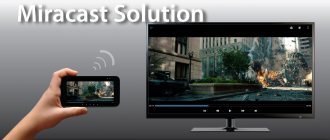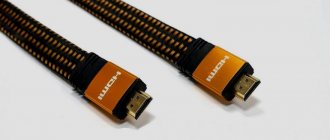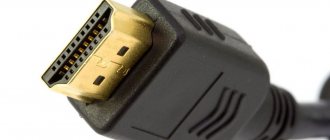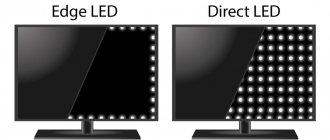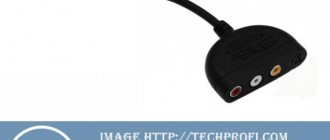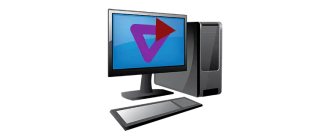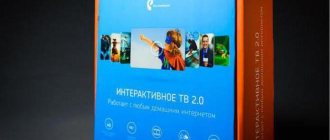What is ADSL technology?
As you already understand, ADSL technology is a technology for connecting to the Internet via wired networks, in particular telephone wires such as twisted pair. The essence of the technology is the ability to carry out high-speed data transmission over twisted pair telephone wires.
To implement this technology, an ADSL line is created that connects two ADSL modems. A twisted pair telephone cable is used to connect ADSL line modems. Each modem is connected to a telephone cable via an RJ-11 connector.
The technology creates 3 channels of information transmission:
- Downdraft;
- Updraft;
- POTS telephone channel.
In this case, the telephone channel is allocated by filters and does not depend on the ADSL connection.
IDSL (ISDN Digital Subscriber Line - IDSN digital subscriber line)
IDSL technology provides full duplex data transmission at speeds up to 144 Kbps. Unlike ADSL, IDSL's capabilities are limited to data transmission only. Despite the fact that IDSL, like ISDN, uses 2B1Q modulation, there are a number of differences between them. Unlike ISDN, the IDSL line is a non-switched line that does not increase the load on the provider's switching equipment. Also, an IDSL line is “always on” (like any line organized using DSL technology), while ISDN requires a connection to be established.
Features of ADSL technology
Firstly , ADSL technology is asymmetrical. This means that the speed of data transfer towards the end user is higher than the speed of data transfer from the user to the network. That is, the speed of the downward flow is higher than the speed of the upward flow.
Secondly . Information transmitted over telephone wires using ADSL technology is compressed. For compression, digital signal processing is used using specially created algorithms, advanced analog filters and analog-to-digital converters.
Third . ADSL technology uses a method of dividing the bandwidth of a copper telephone cable into several carrier frequency bands. This separation allows several signals to be transmitted simultaneously over one line.
In this case, different carrier bands simultaneously transmit different parts of the transmitted data. This process is called Frequency Division Multiplexing (FDM), which means frequency division multiplexing of the communication line.
FDM allows you to allocate one band for the upstream data stream, and a second band for the downstream stream. In this case, the downstream range is divided into high-speed channels and low-speed data channels. The upstream is also divided into low-speed data links.
It is possible to overlap the upstream and downstream ranges with Echo Cancellation technology.
Fourthly . ADSL technology allows you to reserve a narrow band of bandwidth for the transmission of regular telephone service (POTS) signals. POTS is Plain Old Telephone Service. When using ADSL, telephone communication will not be disrupted, even during a power outage.
Common cable problems
Inhomogeneity in the cable negatively affects data transmission. Desoldering is a very common phenomenon in Russian wiring. The transmitted signal through the tap is branched and then reflected from the unmatched end of the tap. As a result, there are 2 signals on the receiver side: direct and reflected. The reflected noise in this case can be considered as noise, so its influence on the transmission quality is very noticeable. The mutual influence of subscriber cables on each other is characterized by transient interference. The influence on transmission quality is very complex and has a random factor. For example, the mutual influence of one couple on another may potentially exist, but not manifest itself in any way. But when connecting another ADSL user, the quality of both connections may be affected.
ADSL speed
The first letter in the name ADSL means asymmetric. That is, data transfer from the network to the computer (downstream) and data transfer from the computer to the network (upstream) will occur at different speeds.
The transmission speed depends on the condition of the line, cable cross-section, and the presence of taps. In fact, the limit for an ADSL subscriber line is a length of 3500 - 5500 meters with a cable cross-section of 0.5 mm2.
In practice, ADSL will provide speeds to the computer of 1.5 - 8 Mbit/s, and speeds from the computer from 640 to 1.5 Mbit/s.
Criterias of choice
xDSL modems are endowed with various characteristics, the most important of which are the maximum possible distance from telephone nodes, information exchange speed, symmetric or asymmetric transmission. Knowing the conditions for using xDSL modems and what their differences are, you can choose a device that is more suitable for you. When choosing a modem, it is necessary to clarify certain characteristics of the telephone network: the length of the wire to the telephone exchange, the number of copper pairs of the cable and its quality characteristics, the availability of offers and capabilities of the provider. You should make sure that there is no interference on the line, which could be caused by crossed cable pairs or poor quality cables.
ADSL and Internet
If you want to connect to the Internet via ADSL, you need to understand that you do not need to dial telephone numbers to communicate. ADSL technology immediately creates a broadband channel for data transmission over an existing telephone line.
Immediately after installing the ADSL modem, you will receive a constant high-speed Internet connection. At the same time, only 1% of the bandwidth is left for telephone communications (low frequency up to 4 kHz). 99% goes to ensuring high-speed data transfer. In this case, different frequency bands are used for different functions.
How to connect?
The connection process is performed in a certain sequence:
- First of all, decide on your Internet connection provider. All service providers now support this technology. For the most part, providers provide their clients with all the necessary equipment, for this reason the user will have to spend money just to gain access to the Internet. Subscribers are leased only equipment suitable for certain conditions with the DSL modem itself. But you can also buy it.
- In the future, the service provider will analyze the client number for any barriers to using aDSL. After signing an agreement with the provider and connecting the necessary equipment, your account is activated. This will take no more than two weeks. If there is satisfactory network coverage, the entire process should only take two hours.
- Finally, the connection parameters are configured and the necessary software is installed on the computer or laptop.
IPTV
Setting up IPTV usually does not require any manipulations, however, if the set-top box requires an IP address issued by the provider to operate, then you need to make a number of settings. Go to the “Network” – “WAN” menu and add the “Bridge” connection type and set the values for the “VPI” and “VCI” parameters.
These settings vary by region and can be obtained from your digital TV service provider. It happens that paired values are used, in these cases you need to create 2 “Bridge” connections.
To continue configuration, you need to create a new group in the “Interface Grouping” tab. The name can be arbitrary, but it must contain all the created “Bridge” connections. After creating a group, you need to assign it to one of the free LAN ports. After proper configuration, a signal for IPTV will be received on this port; all other ports will have Internet.
Setting up Wi-Fi
To set up Wi-Fi, you need to use the item of the same name in the main menu.
Right on the main page you can enable or disable Wi-Fi.
There are 3 points here:
- Basic settings. Here you can set the network name “SSID”, select a channel for its operation, activate the network client isolation function and create a guest network.
- Security Settings. Setting up this service allows you to set a password for your wireless network and select an encryption protocol.
- MAC filter. This is a function for filtering connected devices by MAC address. You can either give access to the network only to certain devices, or, conversely, prohibit certain devices from gaining access. If you don't need it, you can disable this filter.
Resetting the 2500U router to factory settings
The DSL modem has hardware and software resets. To return the hardware settings of the 2500U router to factory values, there is a Reset button recessed into a narrow socket. It must be pressed with a thin rod and held for 10-15 seconds. After this, you need to wait for a minute for the blinking to stop. Factory settings will be restored.
To perform a soft reset on the 2500U, after logging into the administration page, click on the “Manual Configure” tab. On the new page, move the cursor over the “System” inscription in the upper right corner, click it and select “Factory settings”. By clicking on the item, start the process of restoring the original values, followed by an automatic reboot of the DSL router.
Login to the web interface
You can configure the router by entering the address: 192.168.1.1 in the address bar of your browser. The default login and password for this model is admin/admin. After successful authorization, the web interface will open.
Depending on the installed firmware version, the interface may differ from the one presented, but the main menu items and the principle of setup and control will remain basic.
Broadband access via DSL
Modern DSL technologies allow the user to access a wide range of services - telephony, television, Internet, home control - over a single subscriber line. Digital subscriber line (DSL) access has been one of the most dynamic trends in telecommunications over the past decade. And the transmission medium used - twisted pair - has the widest distribution in the world in the field of telephony.
High-speed DSL access is still the mainstay in many countries.
Thus, by mid-2006, there were 164 million DSL users in the world. Over the past year, their number in the world has increased by 38%, and in the European Union - by 45%. In Germany, for example, about 92% of all broadband connections are DSL. The development of twisted pair signal transmission methods has led to the emergence of many types of DSL systems. Existing DSL technologies are divided into two subgroups: symmetric and asymmetric access. Symmetric technologies are used, as a rule, in the corporate sector, while asymmetric technologies are intended to provide multimedia network access services to individual subscribers. Various technologies for multiplexing subscriber lines are designated by their own abbreviations: ADSL, HDSL, RADSL, SHDSL, VDSL. All of them represent different methods of transmitting digital streams (digitalization), together with voice signals, over a subscriber line (Subscriber Line, SL).
Recently, there has been an increase in symmetrical DSL access services in the corporate sector. The greatest hopes are placed on the SHDSL technology, standardized in 2001 by the International Telecommunication Union ITU-T, which is far superior in its parameters to other symmetrical systems. Asymmetric systems are now most often used for subscriber access. Of these, ADSL and ADSL2+ are the most widespread. VDSL transmission systems can be either symmetrical or asymmetrical.
Connecting to the Internet via a subscriber telephone line is organized as follows (see Figure 1). The telephone signal, passed through a 4 kHz filter, is mixed with the computer signal passed through the modem. The combined signal (from the telephone and from the computer) enters the subscriber line and is transmitted to the communication center. There, in turn, the telephone signal is low-pass filtered (4 kHz) and fed to the telephone switch, and the computer signal is sent to the modem and then sent to the multimedia network. Thus, a standard telephone system can be used to connect home users using DSL technology.
| Figure 1. Broadband access via DSL. |
DSL technologies are the best suited for Russian subscriber lines, since they go directly from the telephone socket to the communication center. Note that in many countries they follow a slightly different approach: the line from the telephone exchange ends near a house or village at a multiplexer. At the same time, in our conditions, the presence of “noodles” - the simplest untwisted single-pair telephone wire running from the outlet to the junction box - has a negative impact. However, when replacing “noodles” with twisted pair, communication centers can quite easily offer a new type of service based on DSL technology - delivering high-speed streams to the subscriber.
The DSL transmission system consists of two modems, the connection of which is carried out by a twisted pair in a symmetrical communication cable (see Figure 1). Thus, DSL modems are classified as devices called "physical line modems." Well-known modems for dial-up lines usually operate through the public switched telephone network (PSTN), that is, through telephone channels and telephone exchanges. Note that if very high demands are placed on station equipment (DSLAM multiplexers, see Figure 1) and it is usually quite expensive, then in relation to subscriber equipment (modems) the main requirement is that they be cheap. This condition poses special challenges for DSL developers.
DSL modems differ from telephone modems in having a much larger frequency range. If telephone modems operate in the standard telephone channel band (0.3-3.4 kHz), then the frequency band occupied by DSL is hundreds of kilohertz - a few megahertz. Accordingly, for the implementation of DSL systems it is necessary that cables provide transmission of such frequencies. This, in fact, is what broadband access is all about.
| Table 1. Types of DSL systems. |
Depending on the method of transmission of the linear signal, they are distinguished (see Table 1):
- DSL systems with serial transmission of signals called “single carrier modulation systems” (Single Carrier Modulation, SCM), which use 2B1Q, CAP, etc. encoding methods;
- systems with parallel transmission of signals on several carrier frequencies, so-called “multi-carrier systems” (Discrete Multitone, DMT). They are used in asymmetric DSL.
Symmetrical DSL technologies such as HDSL, SDSL, SHDSL are single carrier systems (SCM). Asymmetrical DSL, such as ADSL, ADSL2, ADSL2+, uses multi-carrier modulation (DMT). As already mentioned, the VDSL system can be either symmetrical or asymmetrical, and it uses different types of modulation.
The main parameters of a DSL system are throughput and line length. System throughput is determined at a given error rate (BER, typically less than 10-7) and noise margin (NM, typically 6 dB). The line length is conditionally estimated for cases where the DSL uses a pair with a conductor diameter of 0.4 mm and with continuous polyethylene insulation.
DSL properties take into account many requirements, including Ethernet over DSL. This is due to the fact that Ethernet is increasingly being used in communication networks, displacing ATM. In addition, almost all local networks now use Ethernet, and support for the corresponding functionality provides additional convenience when using DSL. In addition, modern DSL systems have advanced diagnostic capabilities, including constant monitoring of the line condition at both ends, measurement of interference, line attenuation, its noise immunity, signal-to-interference ratio at both ends of the line, etc.
CHARACTERISTICS OF DSL SYSTEMS
Increasing the range in DSL technology is achieved due to the fact that the digital processing of the signal transmitted over the line takes into account the features of the laid cable. By using a mathematical model of a specific line, the modem is tuned to accurately reproduce the signal, thereby dramatically reducing the required frequency bandwidth.
The HDSL compression system provides transmission mode at a speed of about 2 Mbit/s in both directions, over one or two pairs of wires over a distance of up to 10 km. ADSL equipment, on the contrary, is designed for asymmetric transmission with speeds of 6-8 Mbit/s towards the subscriber, and 840 Kbit/s or less towards the communication center. RADSL differs from the technologies mentioned above in that it supports either a symmetric mode with a speed of about 1 Mbit/s, or an asymmetric mode with a speed to the subscriber of up to 8 Mbit/s. SDSL generally stands for symmetrical transmission over one pair; IDSL is a modification of ISDN (Integrated Services Digital Network).
Let's take a closer look at the two most developed technologies - High-bit-rate Digital Subscriber Line (HDSL) and Asymmetric Digital Subscriber Line (ADSL).
Many foreign companies offer HDSL equipment. Of these, Ascend, Huawei, PairGain, RAD Data Communication and Schmid Telecom, ZyXEL, etc. became famous in Russia at different times. The PairGain company (now ADC KRONE) produces equipment for both users and small offices. RAD Data offers efficient, low-cost modems for streaming speeds of around 2 Mbps over regular telephone cables. In principle, RAD Data produces the entire necessary set of equipment for digitalization of communication lines.
Schmid Telecom's HDSL system, called Watson, transmits 1-2 Mbit/s streams over a single pair of wires. The equipment can be installed and debugged in a few hours. For linear transmission, Watson uses two encoding technologies - 2B1Q and CAP. Watson 2 with the 2B1Q code is capable of transmitting 1168 Kbps over one pair, while Watson 4 with the CAP 128 code is capable of transmitting 2320 Kbps.
A special feature of asymmetric ADSL technology is the use of two coding methods: Carrierless Amplitude and Phase (CAP) and Discrete Multi Tone (DMT). ADSL requires the use of modems at both ends of the line - at the PBX and at the subscriber's. If a modem supporting CAP is mounted on one end of the line, and DMT is installed on the other, then they will be incompatible. The bottom line is that CAP is a coding method with one carrier for each stream direction: 900 kHz for downstream; 75 kHz - for upstream (4 kHz - for telephone). In the DMT multi-carrier modulation method, a digital channel is divided into 256 subchannels and digital streams are transmitted on each of them. As you can see, the methods are different, and to ensure normal functioning it is necessary to ensure that the equipment in the subscriber lines operates in accordance with the same system.
ADSL technology was originally developed with video-on-demand service in mind and was therefore intended to transmit a continuous stream. Its use for the Internet required adapting ADSL to computer exchange protocols. Now let's give examples of ADSL equipment.
Ascend (acquired by Lucent Technologies) produces related equipment as part of a series of DSL systems. In particular, for the MAX TNT hub, it supplies an ADSL-CAP card operating over one pair of wires with the following characteristics: downstream speed - up to 6.14 Mbit/s, upstream - up to 640 Kbit/s, if the transmission range does not exceed 3 ,7 km; the corresponding parameters are 1.5 Mbit/s and 64 Kbit/s at a distance of up to 5.5 km. Ascend RADSL equipment is already equipped with the second generation of CAP technology chips.
The company's approach to organizing flows on PBXs is very interesting. It is proposed to route the main telephone traffic through a telephone switch, and data through a switching hub. This change in the structure of the communication center is caused by the following. According to Bell Communications Research, connecting to computer networks has led to an increase in the duration of the connection with the PBX from 3 to 20 minutes, and in some directions - up to 1 hour. The use of a switch for computer exchange eliminates this problem. Using the MAX switching hub, Ascend aims to redistribute the traffic so that it provides a gradual transition from one DSL stage to another. First - to IDSL, then to SDSL and, finally, the introduction of full-scale ADSL.
As a typical example of equipment with ADSL2+ support, we will cite the DSLAM 6808 access multiplexer from Corecess. This system is installed at the provider and is capable of servicing 384 subscriber lines. In addition to the ADSL2+ protocol (transfer speed up to 24 Mbit/s), it supports regular ADSL (up to 8 Mbit/s) and SHDSL (up to 4.6 Mbit/s), is equipped with two Gigabit Ethernet ports and four 10/100BaseTX/FX ports. The less powerful Corecess 6804N multiplexer has a capacity of 192 subscriber lines, supports the same protocols, contains Gigabit Ethernet and 10/100/1000BaseT, as well as 10/100BaseTX/FX ports. As you can see, the capacity of both systems is sufficient to service both several apartment buildings and an entire microdistrict. Various protocols are supported by the multiplexer so that the operator does not have to refuse subscribers who have modems of outdated systems. Gigabit Ethernet ports give the ASDL2+ provider access to metropolitan (MAN) and wide area (WAN) Ethernet networks.
Recently, DSL access has been rapidly improving. Not long ago, the ADSL2+ standard was adopted, and in May 2005, the International Telecommunication Union ITU-T introduced the VDSL2 standard (Very-High-Bit rate DSL, ultra-high-speed DSL). The new standard provides transmission speeds of up to 100 Mbit/s in both directions. This speed is realized when the distance from the distribution node to the user does not exceed 350 m. At large distances, the VDSL2 speed drops, but does not fall below 12 Mbit/s.
At a similar speed, VDSL2 can operate at the same distance as ADSL today, i.e. from 4.5 to 5 km.
To achieve a speed of 100 Mbit/s at a distance of 350 m, the frequency range of the system has been expanded from 12 to 30 MHz. The VDSL2 chipset is backward compatible with ASDL2+, as providers' distribution sites now primarily house the corresponding equipment. If VDSL2 cards are later installed in the multiplexer, users will not have to replace their ASDL2/ASDL2+ modems. This makes it possible to gradually migrate from one system to another, i.e. from ASDL2 to VDSL2.
Sometimes a DSL provider cannot access subscriber lines, so it runs its own balanced cable to an individual home or group of homes. A hub is installed in the house, and individual users are connected to it using twisted pair cables. In this case, the provider gets rid of the need to rent city lines and can pursue its own technical policy and set prices. The transmission speed of the ASDL2+ system is sufficient to connect users in a large building, so there are no difficulties.
CALL LINE
To get a digital subscriber line (DSL), you must have a regular subscriber line. A typical local line (see Figure 2) consists of a pair of wires from the telephone jack to a junction box; from it it goes further along the cable to the distribution coupling and the cabinet, most often located directly on the street; then (omitting unimportant details) - via a city multi-pair cable to the telephone exchange. With such a superficial description, a subscriber line is essentially two wires passing through many connections (in boxes, couplings, cabinets, on a cross-connect) and ending at the PBX equipment. In fact, there are even more inhomogeneities in a real line than shown in Figure 2. In particular, individual sections of this line can be laid with a cable with different core diameters, which is not reflected in the figure. The junctions of such cables are characterized by increased reflections, which leads to a distortion of the frequency response of the line.
As you move away from the telephone exchange, the number of pairs in the cable decreases, and the length and diameter of the cores increase. This distribution of telephone cables is due to economic and network considerations. Therefore, a typical subscriber line consists of serially connected sections of twisted pair of various lengths with wires of different diameters. Such sections of the subscriber line differ in input impedance, which in practice leads to the appearance of reflected signals at the junctions of these sections. A real subscriber line can have a large number of splices (about 20 or more), not counting the joints shown in Figure 2.
However, this is only part of the problem. Poor quality splices are one of the reasons for disruption of the normal operation of a digital subscriber line. Since there are many joints and splices, the likelihood of poor-quality places occurring is high. The influence of splices on line operation is manifested in two ways. Firstly, oxidation of splices causes noise to appear when the subscriber line operates in the PSTN network. It goes without saying that these noises can be even more dangerous when the line is operating in DSL mode. Secondly, the influence of splices on the operation of DSL can manifest itself in the form of a sharp increase in the resistance of the loop, even in the presence of a “breakthrough” current from the remote power supply. If you detect poor-quality splices, you must act very carefully - under no circumstances should you apply voltage to the line, since the splice is capable of self-healing, which can result in more serious damage. It is better to determine its location using a time-lapse reflectometer (TDR).
Another source of inhomogeneities is taps from the subscriber line (not shown in Figure 2). A tap is a section of twisted pair that is connected parallel to the subscriber line and is open at the end. Branches are formed during the operation of subscriber lines as a result of additional connections. The tap usually consists of cross-connecting wires and the twisted pair section itself. A separate type of parallel outlet is an additional telephone socket, which is usually present in every apartment. These taps are especially harmful if they are located close to the DSL modem input. In this situation, the received signal is small, and the signal reflected from the tap output, on the contrary, is large. The best way to eliminate the impact of such taps is to eliminate unused sockets along with the taps. As a last resort, special microfilters can be installed in parallel sockets.
Practice has shown that the presence of taps can lead to a reduction in transmission speed by 300 Kbps. Many DSL systems include signal processing algorithms and devices to reduce the negative impact of taps on line transmission. When a subscriber line operates in DSL mode, the number of parallel taps is normalized. According to the US standard, the total number of bends should not exceed 8 m, their total length should not exceed 750 m, and the maximum length of an individual bend should be 600 m.
The subscriber line is characterized by a number of parameters. One of the most important, Return Loss (RL), describes the reflections that occur in a real line. The appearance of not only incident waves in a line, but also reflected ones can be caused by many factors (cable structure, installation defects, formation of subscriber lines from different construction lengths, etc.). For example, when connecting building lengths of cable, numerous reflections occur at the joints.
The measure of the reflections that arise in this case is the parameter RL, which is larger the smaller the reflections in the circuit. When evaluating RL, the input impedance of a twisted pair is compared with the average characteristic impedance for a given cable. The main consequence of line irregularity is the appearance of reflected signals. These signals, in turn, experience re-reflections at points of other inhomogeneities. Thus, multiple reflected interference appears in the line, the direction of which coincides with the main signal. The resulting “following stream” significantly degrades the quality of transmission and causes a disruption in the smoothness of the frequency characteristics of the line and the appearance of a “tail” in the main signal.
The next parameter, which is very important for signal transmission, is the operating attenuation of the line. The fact is that the total attenuation of all cable sections connected into a line is not yet sufficient to determine its operating parameters. Reflections at the input and output of the line, as well as from joint inhomogeneities, increase losses in the line and worsen its frequency response. Note that in long-distance communication lines this effect does not manifest itself so strongly, since during their construction very much attention is paid to the selection of construction cable lengths and methods of connecting them to each other. In urban communication lines, until recently, such importance was not attached to the selection of construction lengths and their careful joining, since only low frequencies of telephone conversations were subject to transmission. Significantly higher frequencies are already transmitted via DSL, and therefore increased requirements are imposed on the frequency response of the subscriber line. The criterion for the suitability of a subscriber line as a DSL transmission medium is the amount of operating attenuation at the reference frequencies. For symmetrical systems, the reference frequencies chosen are 150 and 300 kHz; for asymmetric systems using multi-frequency transmission, reference frequencies lie in the range from 40 to 1100 kHz.
Interference, which can be internal or external, has a great influence on transmission over twisted pair cables. Internal noise usually includes intrinsic thermal noise and reflection interference, the appearance of which is caused by numerous inhomogeneities. External interference is caused by the influence of neighboring pairs of the same cable, telephone exchange equipment, high current lines, radio stations, etc. The latter, in turn, can be divided into stationary and random.
Stationary external interference usually includes influences, the appearance of which is due to the normal operation of the sources of this interference - neighboring pairs of the same cable and other closely located communication cables, as well as radio stations, power lines. Nonstationary processes include transient processes in power supplies of telephone exchanges and in power lines, atmospheric phenomena (lightning), etc. Interference in this group is a random sequence of short pulses of relatively high power; they are also called impulse noise. For twisted pair cables, external interference is the determining factor. Of the entire class of external interference, transient interference can be especially distinguished, since it has the greatest impact on signal transmission.
CABLES FOR DSL
City telephone cables constitute one of the most widespread groups of cable products. To provide communications to a thousand subscribers, an average of 60 km of cable is required in 50-pair terms, i.e. 3000 km of twisted pair.
In urban networks, cables with air-paper (tubular and pulp paper) and polyethylene (solid and porous) insulation have been used. The latest communication cables use film-porous polyethylene insulation. The conductors are made of annealed copper wire, grade MM, and their diameter is 0.32; 0.4; 0.5; 0.64 and 0.7 mm. There are a great variety of urban cable designs with copper conductors and polyethylene insulation. Among the latest developments, it is worth mentioning low-pair cables with a capacity of 6 and 11 pairs with copper conductors with a diameter of 0.4 mm, in a polyethylene (for external installation) and polyvinyl chloride (for internal installation) sheath, intended for installation in homes.
The electrical parameters of urban communication cables are standardized at the following tonal frequencies: 800 Hz (Russia), 1000 Hz (USA), 1300 Hz (Germany) and 1600 Hz (Great Britain). Other parameters are set over a wide frequency range. These include: transmission parameters, influence parameters and line noise. The primary parameters are resistance R, capacitance C, inductance L and conductance G. The primary parameters of a typical twisted pair cable with a core diameter of 0.4 mm and polyethylene insulation are presented in Table 2.
| Table 2. Primary parameters of a twisted pair with a conductor diameter of 0.4 mm and polyethylene insulation. |
Secondary parameters of city telephone cables are the propagation constant γ and the characteristic impedance ZB. The parameter γ depends on the primary parameters R, C, L and G and is a complex quantity consisting of the attenuation coefficient α and the phase coefficient β. Based on these parameters, all cable characteristics in the operating frequency range are calculated.
The influence parameters between the two pairs include: crosstalk at the near end (Near End Crosstalk, NEXT); crosstalk at the far end (Far End Crosstalk, FEXT); near-end security (ACR); far-end security (ELFEXT). The definition of these parameters is given in Figure 3.
| Figure 3. Determination of parameters of influence of two pairs. |
Figure 4 shows a comparison of the NEXT parameter for a conventional telephone cable TPPep 10x2x0.5 and a cable specially designed to support DSL MVPV 25x2x0.5, manufactured by. Both cables have copper core diameters of 0.5 mm and approximately the same linear attenuation, but are fundamentally different in transient attenuation. Note that the TPPep 10x2x0.5 cable is the most commonly used “ten-pipe” for residential buildings. From Figure 4 it is obvious how much better the newly developed cable is at NEXT than the widely used TPPep.
| Figure 4. Average value of transient attenuation NEXT of TPPep and MVPV cables. |
The special characteristics for DSL pose a particular challenge, since in digital transmission factors that are not as important for analogue transmission systems play a large role. These include quantization noise, pulsed and radio frequency interference, and structural return losses. Typically, cables designed for DSL systems that use symmetrical transmission perform equally well at transmitting both upstream and downstream traffic. At the same time, they make it possible to implement asymmetric systems on them, providing transmission from the station to the subscriber (downstream) at a higher speed than from the subscriber to the station (upstream).
DSL systems were originally designed to work over already installed, in-use telephone lines. Gradually it became clear that city communication lines are strikingly different in their characteristics from each other. The cables used for local lines also vary greatly. DSL systems operate over different cables in different ways: with some they work very well, without any difficulties, while with others they work either with great difficulty or do not work at all. In this regard, a task arose - to unify cables for DSL, as well as to develop a new series of digital city cables designed for DSL. Specialists from the Sevkabel Research Institute and the Leningrad Industrial Research Institute of Communications took on this task and began developing digital broadband access cables for DSL.
In general, the following technical requirements apply to DSL cables:
- cables must allow the use of both symmetrical and asymmetrical DSL equipment using CAP and DMT codes;
- the electrical characteristics of the cables must ensure transmission over one pair at speeds that comply with the recommendations of ITU-T G992.1; 2; 3; 4 and 5, including up to 20 Mbit/s for ADSL2+; up to 52 Mbit/s for VDSL2+, in both directions;
- electromagnetic compatibility conditions must allow the operation of ADSL and VDSL systems in multi-wire mode at a speed of 155.52 Mbit/s;
- the length of DSL lines must be at least 1500 m;
- number of pairs in the cable - from 2 to 50;
- conductor diameter - 0.5; 0.64; 0.9 mm;
- use of solid and porous insulation;
- the cable must allow installation in telephone sewers, directly into the ground, inside buildings, and be protected from rodents (if necessary);
- the cable design must prevent longitudinal penetration of moisture;
- The electrical characteristics of the cable at direct current and voice frequencies must comply with GOST R 51311-99.
David Galperovich - candidate of technical sciences, senior researcher at the cable industry design bureau. He can be contacted by phone. (495) 583-5472.


